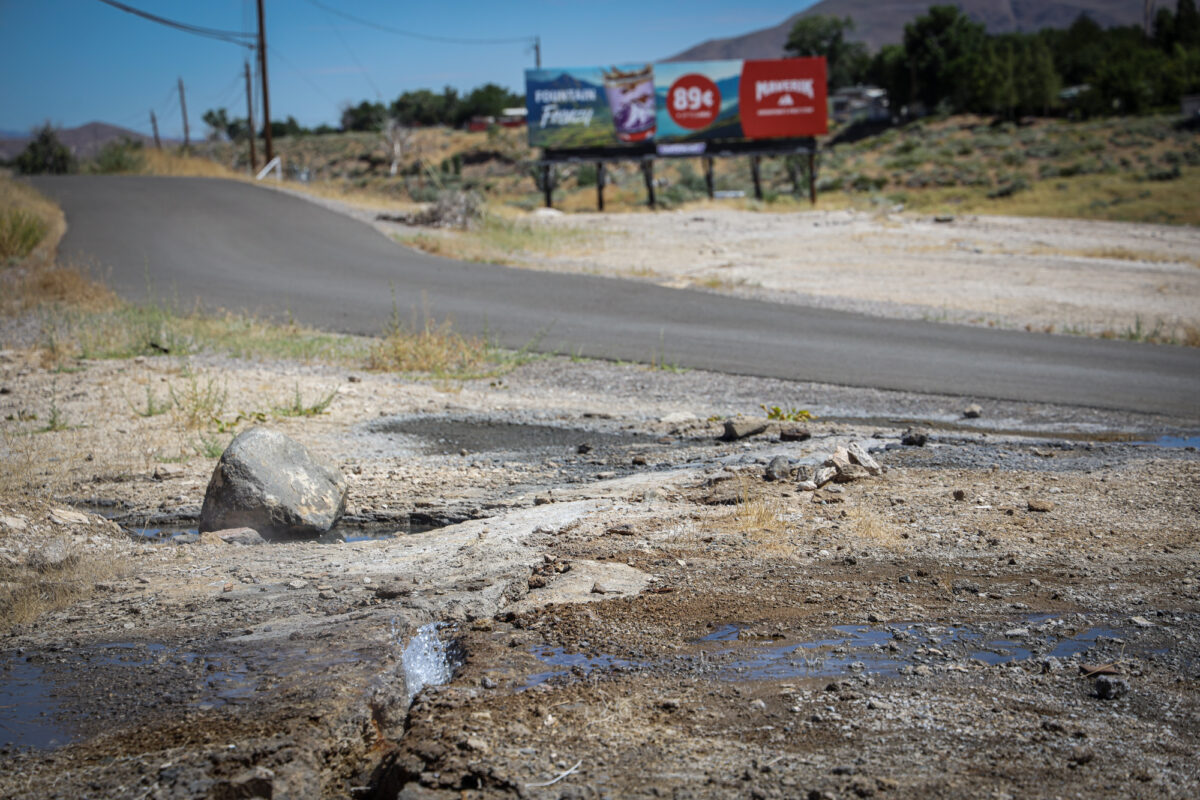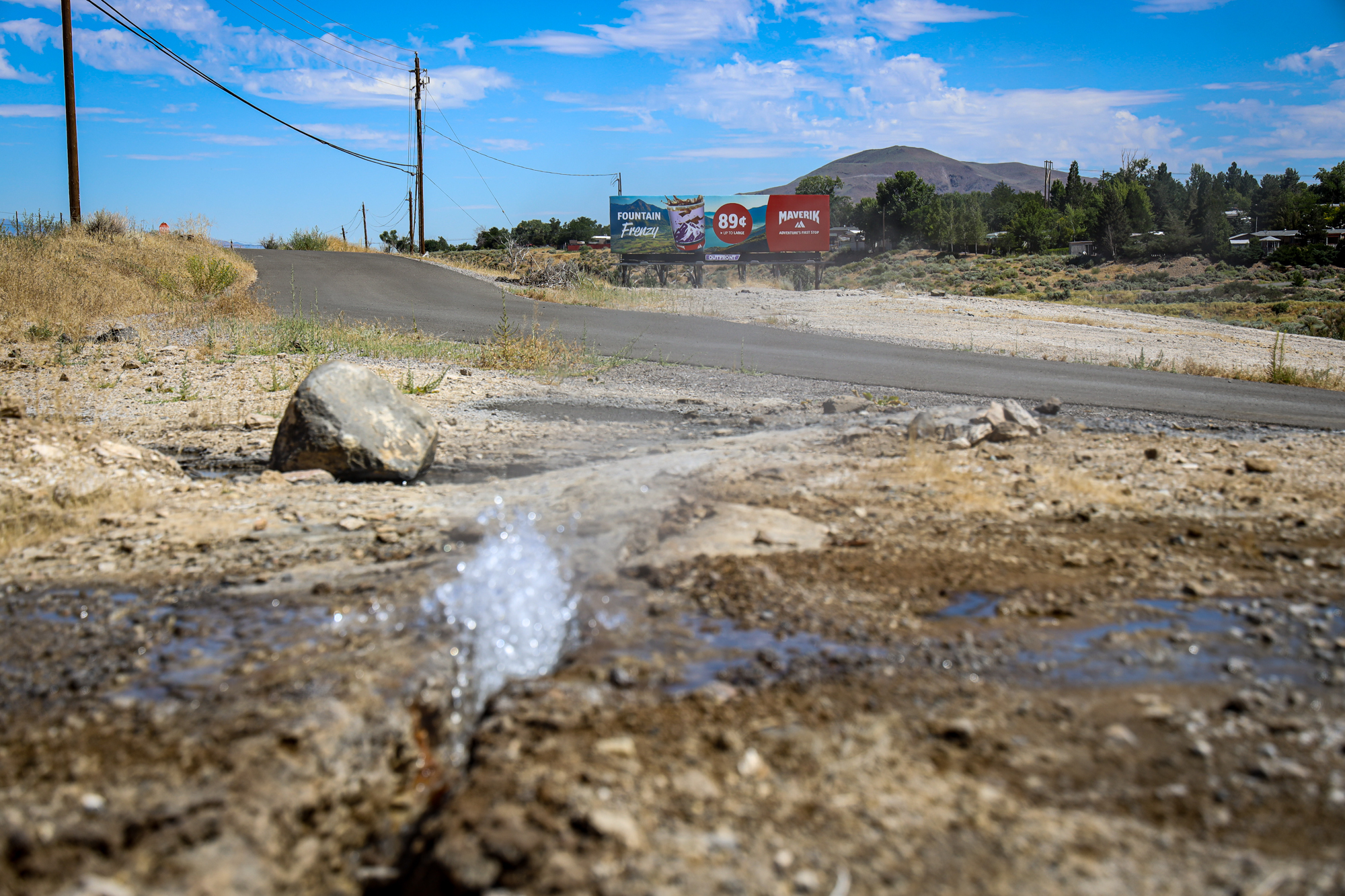Good morning, and welcome to the Indy Environment newsletter. I’m Amy Alonzo, the environment reporter for The Indy.
Writing about water in Nevada usually revolves around the lack of the life-sustaining liquid — despite an epic winter, portions of Southern Nevada remain in drought; the future of the beleaguered Colorado River remains uncertain; and basins across the state are over appropriated.
But over the summer, a Northern Nevada scientist took members of The Indy to look at something unique in Nevada — the surprise return of water to a once active hot spring and geyser. We visited the site again in the fall and saw the amount of water bubbling up had increased. Reno’s Steamboat Hot Springs is fascinating not only because of its storied history, but also because of the role hot springs play in the search for life on other planets.
So often, the Earth shifts and evolves over millions or billions of years. What an amazing treat to watch the Earth shift — no matter how incremental — over just the course of several months.
To get this newsletter in your inbox, subscribe here.

A bubbling cup of icy soda splashes across a south Reno billboard, advertising cold drinks for sale at a nearby market.
Below the billboard, liquid of another kind bubbles up from beneath the Earth’s surface — scalding hot water.
During the past few months, new vents have opened around Steamboat Hot Springs, releasing the scent of hydrogen sulfide into the air and spilling boiling water into fields and driveways.
On cold days, tufts of steam billow up. The hissing of water is audible, heat radiating up from the depths of the Earth.
This water bubbling up and out of Steamboat Hot Springs is brand-new, according to Taylor Wilson, a Reno-based nuclear scientist who showed his findings to The Nevada Independent.
“It’s fascinating this area has reemerged,” he said.
Once a spectacular sight to behold as one of the nation’s largest geysers, Steamboat Hot Springs is now an unassuming landmark in south Reno. Flanking old U.S. Highway 395, the springs have been tapped for development — a geothermal plant on one side, a spa resort on the other. Development combined with geologic activity dried up the springs’ surface water decades ago and, until recently, all that remained were mounds of silica deposits leftover from where hot springs once percolated.
But human settlement near the springs has been just a blip in geologic time, and the hydrothermal system that powers the springs is very dynamic, said Steve Ruff, a planetary geologist at Arizona State University’s School of Earth and Space Exploration who works on Mars exploration projects, including the Spirit rover.
“It’s fun to know that Steamboat is still changing and there’s a dynamic process here that is responding to activity at depth,” he said.
Reemergence of the springs’ surface water is interesting to scientists such as Ruff who study hot springs, one of the few habitats that have preserved evidence of early life on Earth and could provide hints about the possibility of life on other planets.
Hot springs were the first place where scientists were able to isolate extremophiles — microorganisms that can survive scalding temperatures and other extreme conditions. Hot springs can also entomb and preserve cells, making them strong candidates for holding biosignatures of past life. Life in extreme environments is a cornerstone of astrobiology; astrobiologists, in turn, look for signs of ancient hot springs on Mars and other planets.
“Hot springs on Earth, in almost all cases, are great habitats for microbial life — single-cell organisms that live in communities,” Ruff said. Those microbial communities can become entombed in silica that can preserve them for millions or even billions of years.
“On Earth, hot springs means life, and life that can be preserved — let’s go to Mars and see if we can find the same thing,” he said.
‘The devil boils the water’
Steamboat Hot Springs once shot forth as the third-largest geyser in the country. Erupting between 60 and 80 feet in the air, it was surrounded by open pools of boiling water. The springs served as a winter camp for some Native Americans, and it later served as a stopover for emigrants.
At one point, more than 20 geysers were observed, making Steamboat one of the largest geyser fields in the world.
Settlers were quick to capitalize on the area’s potential and, in 1861, a British doctor built a hospital at Steamboat. Later developments included facilities for soaking in the restorative spring water. Scientists of the time were also studying the springs.
Mark Twain wrote about the hot springs in 1863, penning “they are natural — the devil boils the water, and the white steam puffs up out of crevices in the earth … from one spring the boiling water is ejected a foot or more by the infernal force at work below, and in the vicinity of all of them one can hear a constant rumbling and surging, somewhat resembling the noises peculiar to a steamboat in motion.”
Steamboat’s geysers were rivaled by those reported in 1869 in Beowawe (located between Elko and Battle Mountain) where, by 1934, more than 50 unique geysers had been counted. Steamboat and Beowawe were at one time the second and third largest geyser fields in the country after Yellowstone.
Hot spring activity at both locations ceased in the 1980s due to development and natural causes.
At Beowawe, geothermal exploration in the 1950s dried up many of the geysers, and the site fully dried up by 1987 after a geothermal plant began operating.
At Steamboat, a large earthquake in the early 1900s caused the geyser to dry up, and surface flows stopped by the mid-1980s. The decline in surface water was likely caused by the operation of a nearby geothermal power plant, coupled with a regional drought, according to the National Park Service.
Terrestrial hot springs and life on Mars
In 1998, Steamboat Hot Springs was added to the state list of historic places — but its history goes back much further than most humans can fathom. The small field of rhyolitic lava domes, steam vents and fumaroles that comprise the springs range from 1.1 to 2.5 million years old.
Now, the area around Steamboat Hot Springs is quintessential Nevada, a mishmash of natural and man-made icons of the state.
Across old Highway 395 sits Ormat Technologies Inc.’s Steamboat Hills geothermal plant. Its first plant reached commercial operation in 1992, tapping into the region’s 325-degree Fahrenheit water five years after surface flows from Steamboat Hot Springs stopped. Now comprising six plants, the most recent plant began commercial operation in 2020 and the Steamboat geothermal field is one of the world’s most consistent sources of geothermal energy.
“It’s this intersection between the modern Nevada economy with the geological history of the area,” Wilson said.
Rhyolite, a volcanic rock consisting primarily of silica, like that found at Rhyolite Ridge, a massive lithium and boron deposit in central Nevada, covers the hills near the geothermal plant.
Steamboat buckwheat, an endangered flowering plant, grows on 150 acres of public and private land around Steamboat Hot Springs — and nowhere else in the world. The buckwheat thrives in the shallow soil derived from sinter — mineral deposits of silica — discharged by old hot spring flows.
NASA’s Spirit rover, active from 2004 to 2010, found silica deposits on Mars likely caused by hot spring, geyser or fumarolic activity.
In 2016, Ruff and another Arizona State University geoscientist found silica deposits at a hot spring site in Chile with structures similar to those found by the Spirit rover. El Tatio sits above 14,000 feet, with subfreezing nighttime temperatures and intense ultraviolet radiation from the high elevation, making it a good analog for studying potential life on a planet nearly 250 million miles away.
“They’re all in a family of the same type of silica sinter deposit,” Ruff said. “You can learn something about the nature of these hot spring deposits and make comparisons with what they found on Mars.”
Unlike El Tatio, Steamboat hasn’t been a focus for scientists because, until recently, it didn’t have actual hot springs with flowing water and steaming vents.
Nobody knows what the future of the springs will hold. It’s unlikely that the new activity was caused by last year’s heavy snow runoff — it would take years, or decades, for snow to percolate down, heat up, then rise back up to the surface — and is more likely caused by seismic activity, Ruff said. The new activity could last for years, or centuries, depending on what is happening underground, and it could be useful to those who study sinter mounds and other hot springs on Earth.
“The question of life beyond Earth is the profound question we want to address — we only have one place in the whole universe that we know there’s life. Anything beyond Earth is speculation. We have zero examples of life beyond Earth, and Mars is a place we literally can go and attempt to address that fundamental and profound question,” Ruff said. “Even finding long-dead, single-cell organisms on Mars — if they existed — would be a profound new understanding of our place in the universe.”

Here’s what else I’m watching this week:
The Indy shared excellent reporting from Inside Climate News earlier this week about a water-dependent energy project in eastern Nevada that is drawing the ire of White Pine County residents who worry about impacts to their water, dark skies and tourism.
The future of the Colorado River remains up in the air. ProPublica reports on how a Southern California millennial has risen to a position of power when it comes to shaping policy around the river.
Excellent storytelling by Daniel Rothberg about a confluence of water, poetry and art along the Truckee River.
NPR explains how the nation’s plant hardiness maps have been updated, reflecting warming temperatures that are a boon to some gardeners and a bust to others.
Henderson’s city council approved conversion of land that was formerly part of the now defunct Three Kids Mine into a housing development. The mine contains asbestos, arsenic and manganese, the Las Vegas Review-Journal and The Indy’s Carly Sauvageau report.

